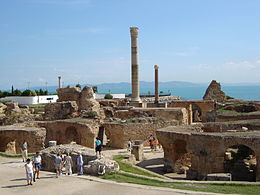CultureWatch Reviews: Carthage Must Be Destroyed and The City of God
In This Issue
The author of Carthage Must Be Destroyed takes a close look at our preconceived notions of Carthage and Carthaginians, colored as they are by the accounts of Greek and Roman writers who had a vested interest in presenting Carthaginians as cruel and duplicitous. The City of God is as rich in lofty thinking, baroque writing, sympathetic characters, vivid settings, and suspense as anything you are likely to see more than once or twice in a lifetime. Take your time, but read it.
Books
CARTHAGE MUST BE DESTROYED
The Rise and Fall of an Ancient Civilization
by Richard Miles, ©2010
Published by Viking Press; 544p
The author of this book has extensive credentials that include teaching at the University of Sydney as well as being a Fellow-Commoner of Trinity Hall, University of Cambridge, and participating in seminars at the Universities of London, Illinois-Champaign-Urbana, and Wisconsin-Madison. His authoritative account of the rise and fall of Carthage covers a thousand years, and paints a fascinating picture of the peoples and cultures that surrounded the Mediterranean Sea between 1000 BC and the spring of 146 BC, when Carthage was indeed destroyed.
He takes a close look at our preconceived notions of Carthage and Carthaginians, colored as they are by the accounts of Greek and Roman writers who had a vested interest in presenting Carthaginians as cruel and duplicitous. The three Punic Wars were ultimately won by Rome, which proceeded to present the world with its own take on history, hardly an unbiased account. Miles has gone a long way to question and disprove the common misperceptions foisted on us by the winners.
Carthage had been founded several hundred years before its fall. Its founders were Phoenicians from the Levant, an area which consisted of a narrow strip of city states like Tyre and Sidon and Biblos along the eastern end of the Mediterranean Sea, an area that nowadays is mostly Lebanon.
Early on, the Phoenicians developed sea-going ships with curved prows, as opposed to the squared-off, flat-bottomed boats of the era. It was these ships, along with the Phoenicians’ physical location on the edge of the sea, which allowed Phoenician traders to create trade routes all over the Mediterranean. Eventually, they were trading along both north and south coasts, all the way to Gades (Cadiz) on the southwestern tip of Spain, just beyond the Pillars of Hercules (Gibralter).
Phoenician trading goods included all sorts of materials worked by their artisans: furniture inlaid with ivory and glass, bronze and silver jewelry holding precious stones, metal bowls and urns, all sorts of domestic items, and fabric and garments dyed an extraordinary shade of deep purple. The dye they used to create these came from crushed, salt-soaked shells, and the color gave the Phoenicians their name, after the Greek word for purple. The remnants of the mollusks, however, gave off such a foul odor that they were thrown well outside the city gates, in huge piles (one was found to be at least 40 meters high).
Among the many peoples with whom Phoenicians traded were the Hebrews familiar to most of us from Biblical accounts, including Kings David and Solomon, as well as Ahab, whose wife, Jezebel, was the daughter of the King of Tyre.
Between 814 and 750 BC, the outpost that was Carthage was founded and developed in North Africa, in what is now Tunisia, on the eastern tip of Cap Bon. Its location gave the Levantine traders a safe port far from home that also was convenient to many of its trading partners, especially those in Sardinia and Sicily.
Carthage was a city governed by a Suffeture (i.e. two elected senior magistrates), a Tribunal of One Hundred and Four (the elites of the city), and a Popular Assembly which anyone could attend but which had very little power. The city was actually governed for many years by clans, most notably the Magids and the Barcids, the latter the clan that produced Carthage’s most famous General, Hannibal Barca.
More Articles
- The Beige Book Summary of Commentary on Current Economic Conditions By Federal Reserve District Wednesday November 30, 2022
- A la Frank Sinatra: "Come Fly With Me", U.S. Department of Transportation Airline Customer Service Dashboard
- Adrienne G. Cannon Writes: Those Lonely Days
- From the CDC: When You've Been Fully Vaccinated You Can ........For the 30,000,000 Who Have Been Vaccinated
- Jill Norgren Reviews a New Inspector Gamache Mystery: All the Devils Are Here
- FactCheck Post: The Facts on Trump’s Travel Restrictions: "We Don't Have a Travel Ban; We Have a Travel Band-Aid Right Now"
- Heard of the Novel Corona Virus Before? The New England Journal of Medicine's Free Reading Lists and the W.H.O.'s Statement
- Horse, Horse, Tiger, Tiger; It's the Tone of the Character That Makes the Word
- Although the Summer Travel Season is Drawing to a Close, A Worldwide Caution is Still in Effect From the State Department; Hong Kong Update
- The Bodleian Library and Worldmapper Create a Cartogram Depicting Trump's Tweets and Countries that Dominate US President's Foreign Policy







